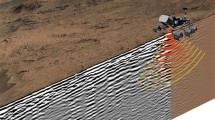Abstract
A realistic 3D view of the epikarst is key to understanding karst groundwater phenomena. Ground penetrating radar proved to be highly effective for investigating the epikarst of a sinkhole located in the Gran Sasso karst range (central Italy). Two different low-frequency antennae (100 MHz bistatic shielded and 40 MHz bistatic unshielded) were used. The radar signal interpretation was correlated with field observations of the epikarst and borehole data. Two radar anomaly surfaces were identified, which were correlated with the top and bottom of the epikarst surface. The shape of the two surfaces correlates well with the surface topography of the study sinkhole and with the orientation of its main joints and karren. The work indicated that such a 3D reconstruction could be usefully applied to karst aquifer vulnerability studies.
Résumé
Une vue 3D de l’épikarst constitue un progrès notable pour la compréhension des écoulements karstiques. Le radar géologique s’est révélé très efficace pour reconnaître l’épikarst d’une dépression karstique située dans la chaîne du Gran Sasso (Italie centrale). Deux antennes basse fréquence (100 et 40 MHz) ont été utilisées. L’interprétation du signal radar a été corrélée avec des observations de terrain relatives à l’épikarst et des données de sondage. Deux discontinuités radar ont été identifiées et reconnues comme les surfaces supérieures et inférieures de l’épikarst. La forme des deux surfaces est contrôlée par la surface topographique de la dépression karstique étudiée et par l’orientation des discontinuités principales et des lapiaz. Le travail réalisé a montré qu’une telle reconstitution 3D pouvait être utile pour des études de vulnérabilité à la pollution d’aquifères karstiques.













Similar content being viewed by others
References
Al-fares W, Bakalowicz M, Guérin R, Dukhan M (2002) Analysis of the karst aquifer structure of the Lamalou area (Hérault, France) with ground penetrating radar. J Appl Geophys 51(2–4):97–106
Bristow CS, Jol HM (eds) (2003) Ground penetrating radar in sediments. Geological society, Special Pubblications, London, p 211
Cunningham KJ (2004) Application of ground-penetrating radar, digital optical borehole images, and cores for characterization of porosity hydraulic conductivity and paleokarst in the Biscayne aquifer, southeastern Florida, USA. J Appl Geophys 55:61–76
Daly D, Dassargues A, Drew D, Dunne S, Goldscheider N, Neale S, Popescu I, Zwahlen F (2002) Main concepts of the “European approach” to karst-groundwater-vulnerability assessment and mapping. Hydrogeol J 10(2):340–345
Daniels DJ (1996) Surface-penetrating radar. Short Run Press Ltd., Exeter, UK
Davis JL, Annan AP (1989) Ground-penetrating radar for high-resolution mapping of soil and rock stratigraphy. Geophys Prospecting 37:531–551
Doerfliger N, Zwahlen F (1995) National report from Switzerland. In: COST Action 65 Report ‘Hydrogeological aspects of groundwater protection in karstic areas. In Cost action-65 Hydrogeological aspects of groundwater protection in karstic areas. Final report. European Commission, EUR 16547, Office for Official Publications of the European Communities, Luxembourg, pp 3–34
Drew DP, Orvan J, Pulido Bosch A, Salaga I, Sarin A, Tulipano L (1995) The characteristics of karst groundwater systems. In Cost action-65 Hydrogeological aspects of groundwater protection in karstic areas. Final report. European Commission, EUR 16547, Office for Official Publications of the European Communities, Luxembourg, pp 349–369
Ford D, Williams P (1989) Karst geomorphology and hydrology. Chapman & Hall, London
Lore’ A, Magaldi D, Tallini M (2002) Morphology and morphometry of the Gran Sasso (Central Italy) surface karst. Geografia Fisica e Dinamica Quaternaria 25(2):123–134
Magaldi D, Tallini M (2000) A micromorphological index of soil development for the Quaternary geology research. Catena 41:261–276
Magaldi D, Tallini M (2002) Carta delle Unità di Gestione della catena del “Gran Sasso d’Italia” e delle aree limitrofe (Italia centrale) S.EL.CA., Florence
Thierry P, Debeblia N, Bitri A (2004) Geophysical and geological characterisation of karst hazards in urban environments: application to Orléans (France)—Bulletin of Engineering Geology and the Environment DOI 10.1007/s10064-004-0247-4
Acknowledgements
The authors thank MIUR (“Ambiente terrestre” project – “Cluster C11b” subproject – D.L. 720/99) for its financial support, Prof. D. Magaldi for his critical review of a first version of the paper and Eng. Guido Manacorda (Ingegneria dei Sistemi, Pisa, Italy) for some useful suggestions on GPR technology.
Author information
Authors and Affiliations
Corresponding author
Rights and permissions
About this article
Cite this article
Tallini, M., Gasbarri, D., Ranalli, D. et al. Investigating epikarst using low-frequency GPR: example from the Gran Sasso range (Central Italy). Bull Eng Geol Environ 65, 435–443 (2006). https://doi.org/10.1007/s10064-005-0017-y
Received:
Accepted:
Published:
Issue Date:
DOI: https://doi.org/10.1007/s10064-005-0017-y




